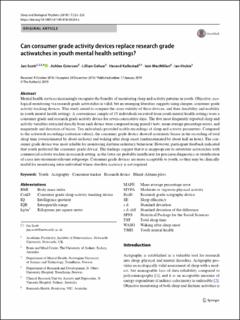| dc.contributor.author | Scott, Janine Linda | |
| dc.contributor.author | Grierson, Ashlee | |
| dc.contributor.author | Lillian, Gehue | |
| dc.contributor.author | Kallestad, Håvard | |
| dc.contributor.author | MacMillan, Iain | |
| dc.contributor.author | Hickie, Ian | |
| dc.date.accessioned | 2021-04-28T09:48:53Z | |
| dc.date.available | 2021-04-28T09:48:53Z | |
| dc.date.created | 2019-04-11T12:48:33Z | |
| dc.date.issued | 2019 | |
| dc.identifier.citation | Sleep and Biological Rhythms. 2019, 17 (2), 223-232. | en_US |
| dc.identifier.issn | 1446-9235 | |
| dc.identifier.uri | https://hdl.handle.net/11250/2740119 | |
| dc.description.abstract | Mental health services increasingly recognize the benefits of monitoring sleep and activity patterns in youth. Objective, ecological monitoring via research grade actiwatches is valid, but an emerging literature suggests using cheaper, consumer grade activity tracking devices. This study aimed to compare the cross-validity of these devices, and their feasibility and usability in youth mental health settings. A convenience sample of 13 individuals recruited from youth mental health settings wore a consumer grade and research grade activity device for seven consecutive days. The five most frequently reported sleep and activity variables extracted directly from each device were compared using paired t tests, mean average percentage errors, and magnitude and direction of biases. Ten individuals provided usable recordings of sleep and activity parameters. Compared to the actiwatch recordings (criterion values), the consumer grade device showed systematic biases in the recording of total sleep time (overestimated by about an hour) and waking after sleep onset (underestimated by about half an hour). The consumer grade device was most reliable for monitoring daytime sedentary behaviour. However, participant feedback indicated that youth preferred the consumer grade device. The findings suggest that it is inappropriate to substitute actiwatches with commercial activity trackers in research setting, as the latter are probably insufficient for precision diagnostics or stratification of cases into treatment relevant subgroups. Consumer grade devices are more acceptable to youth, so they may be clinically useful for monitoring intra-individual where absolute accuracy is not required. | en_US |
| dc.language.iso | eng | en_US |
| dc.publisher | Springer | en_US |
| dc.rights | Navngivelse 4.0 Internasjonal | * |
| dc.rights.uri | http://creativecommons.org/licenses/by/4.0/deed.no | * |
| dc.title | Can consumer grade activity devices replace research grade actiwatches in youth mental health settings? | en_US |
| dc.type | Peer reviewed | en_US |
| dc.type | Journal article | en_US |
| dc.description.version | publishedVersion | en_US |
| dc.source.pagenumber | 223-232 | en_US |
| dc.source.volume | 17 | en_US |
| dc.source.journal | Sleep and Biological Rhythms | en_US |
| dc.source.issue | 2 | en_US |
| dc.identifier.doi | 10.1007/s41105-018-00204-x | |
| dc.identifier.cristin | 1691623 | |
| cristin.ispublished | true | |
| cristin.fulltext | original | |
| cristin.qualitycode | 1 | |

